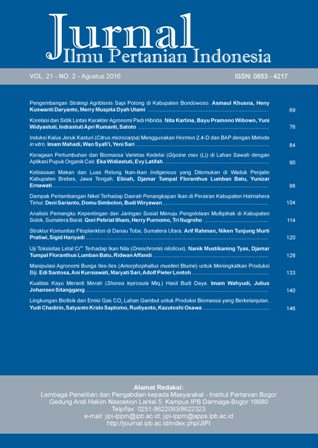Korelasi dan Sidik Lintas Karakter Agronomi Padi Hibrida
Abstract
Two approachment to increase yield productivity with new variety throught new plant type (NPT) concept and heterosis exploitation of hybrid rice. The research was to evaluated yield and yield component of 36 hybrid rice genotypes in preliminary yield trial at two locations. The experiment was conducted in the second season MT (II) 2013 at the Sukamandi experimentalstation, Subang, West JavaProvince and in Batang, Central Java Province by usingRandomized Complete Block Design (RCBD). The material used were36hybrid rice genotypes and four check varieties namely Hipa8, Hipa Jatim2,Ciherang, and Longping Optima. The results showed that grain yield had been effected by location, genotypes, and both interactions. There were two hybrid rice genotypes that give high yield potential than four check varieties, and one hybrid rice genotype significantly different from Longping Optima. Those hybrids were GMJ6/CRS519 (9.9 t/ha) and GMJ14/CRS757 (9.5 t/ha), and A1/CRS518 (6.2 t/ha). Based on path analysisnumber of productive tiller and number of total grain per panicle have direct effect to yield with path coefficient as 0.4028 and 0.2153. Length panicle and seed set also gave positif and significant direct effect to yield as 0.095 and 0.0956, so these characteristics could be used as selection criteria.Downloads
References
Asadi, Sumartono M, Woerjono H, Jumanto. 2004. Keefektifan metode seleksi modifikasi bulk dan pedigri untuk karakter agronomi dan ketahanan terhadap virus kerdil (SSV) galur- galur F7 kedelai. Zuriat. 15(1): 64-76.
Cheng SH, Cao LY, Zhuang JY, Chen SG, Zhan XD, Fa YY, Zhu DF, Min SK. 2007. Super hybrid rice breeding in China: achievements and prospects. Journal of Integrative Plant Biology. 49(6): 805-810. http://doi.org/cf7k78
Devarathinam A. 1984. Studies of heterosis in relation to per se performance in rainfed rice. The Madras Agricultural Journal. 7: 568-572.
Gomez KA, Gomez AA. 1985. Statistical Procedures for Agricultural Research. Canada: John Willey dan Sons, Inc.
International Rice Research Institute. 2014. Standard Evaluation System for Rice. Los Banos, Philippines: International Rice Research Institute.
Kartina N, Widyastuti Y, Satoto. 2014. Keragaan karakter agronomi padi hibrida baru. Buletin Plasma Nutfah. 20 (2): 58-64.
Munarso YM. 2011. Keragaan padi hibrida pada sistem intermitten dan tergenang. Jurnal penelitian Tanaman Pangan. 30(3): 189-195.
Peng S, Khush GS, Virk P, Tang Q, Zou Y. 2008. Progress in ideotype breeding to increase rice yield potential. Field Crops Research. 108(1): 32-38. http://doi.org/ds2xrg
Pramudyawardani EF, Suprihatno B, Mejaya MJ. 2014. Potensi hasil galur harapan padi sawah ultra genjah dan sangat genjah. Jurnal Penelitian Pertanian Tanaman Pangan. 34(1): 1-11.
Rochaeni WR, Permadi K. 2012. Analisis sidik lintas beberapa karakter komponen hasil terhadap daya hasil padi sawah pada aplikasi agrisimba. Agrotrop: Journal on Agriculture Science. 2(2): 185-190.
Safitri H, Purwoko BS, Dewi IS, Abdullah B. 2011. Korelasi dan sidik lintas karakter fenotipik galur-galur haploid ganda hasil kultur antera. Widyariset. 14(2): 295-303.
Satoto, Sudibyo TWU, Widyastuti Y. 2008. Seleksi galur-galur pelestari dan pemulih kesuburan serta pembentukan galur mandul jantan baru padi hibrida. Prosiding Seminar Nasional Padi. Inovasi Teknologi Padi Mengantisipasi Perubahan Iklim Global Mendukung Ketahanan Pangan Buku 1. Balai Besar Penelitian Tanaman Padi . Hal : 255-268.
Satoto, Mejaya MJ, Widyastuti Y, Rumanti IA. 2013. Stabilitas dan potensi hasil varietas unggul baru padi hibrida. Jurnal Penelitian Tanaman Pangan. 32(2): 67-73.
Sembiring H, Didik S, Akmal, Marbun T, Woodhead T, Kusnadi. 2007. Strategi pengelolaan pupuk nitrogen, modifikasi jarak tanam, dan penambahan pupuk mikro untuk menekan kehampaan gabah padi tipe baru. hlm. 173-196. Dalam Bambang Suprihatno, Aan A. Daradjat, Hendarsih Suharto, Husin M.Toha, Agus Setiyono, Suprihanto, Agus S. Cahya Prosiding Seminar Apresiasi Hasil Penelitian Padi Menunjang P2BN. Buku I. Sukamandi: Balai Besar Penelitian Tanaman Padi.
Singh RK, Chaudary BD. 1979. Biometrical Method In Quantitative Genetic Analysis. New Delhi (IN): Kalyani Publ.
Virk PS, Kush GS, Kumar S. 2004. Breeding to enhance yield potential of rice at IRRI: The ideotype approach. International Rice Research Notes. 29(1): 5-9.
Virmani SS. 1994. Heterosis and hybrid rice breeding: 163-189 In Frankel R. Monograph on Theoritical and Applied Genetics 22. Springer-Verlag, Berlin, NY, London, Paris, Tokyo, Hongkong, Barcelona, Budapest-IRRI, Philippines. http://doi.org/ddp2vv
Virmani SS, Kumar I. 2004. Development and use of hybrid rice technology to increase rice productivity in the tropics. International Rice Research Notes. 29(1): 10-19.
Wening RH, Susanto U. 2014. Skrining plasma nutfah padi terhadap cekaman kekeringan. Majalah Widyariset. 17(2): 193-203.
Widyastuti Y, Satoto. 2007. Evaluasi heterosis tahap awal sejumlah kombinasi baru padi hibrida. Apresiasi hasil Penelitian Padi. 687-696.
Widyastuti Y, Satoto, Rumanti IA. 2015. Performance of promising hybrid rice in two different elevations of irrigated lowland in Indonesia. Jurnal Agrivita. 37(2): 169-177. http://doi.org/bm9g
Yang WS, Peng RC, Laza RM, Visperas, Dionisio-Sese ML. 2007. Grain yield and yield attributes of new plant type and hybrid rice. Crop Science. 47(4): 1393-1400. http://doi.org/d32qjk
You A, Lu X, Jin H, Ren X, Liu K, Yang G, Yang H, Zhu L, He G. 2006. Identification of quantitative trait loci across recombinant inbred lines and testcross populations for traits of agronomic importance in rice. Genetics. 172(2): 1287-1300. http://doi.org/bhkmqm
This journal is published under the terms of the Creative Commons Attribution-NonCommercial 4.0 International License. Authors who publish with this journal agree to the following terms: Authors retain copyright and grant the journal right of first publication with the work simultaneously licensed under a Creative Commons Attribution-NonCommercial 4.0 International License. Attribution — You must give appropriate credit, provide a link to the license, and indicate if changes were made. You may do so in any reasonable manner, but not in any way that suggests the licensor endorses you or your use. NonCommercial — You may not use the material for commercial purposes.























